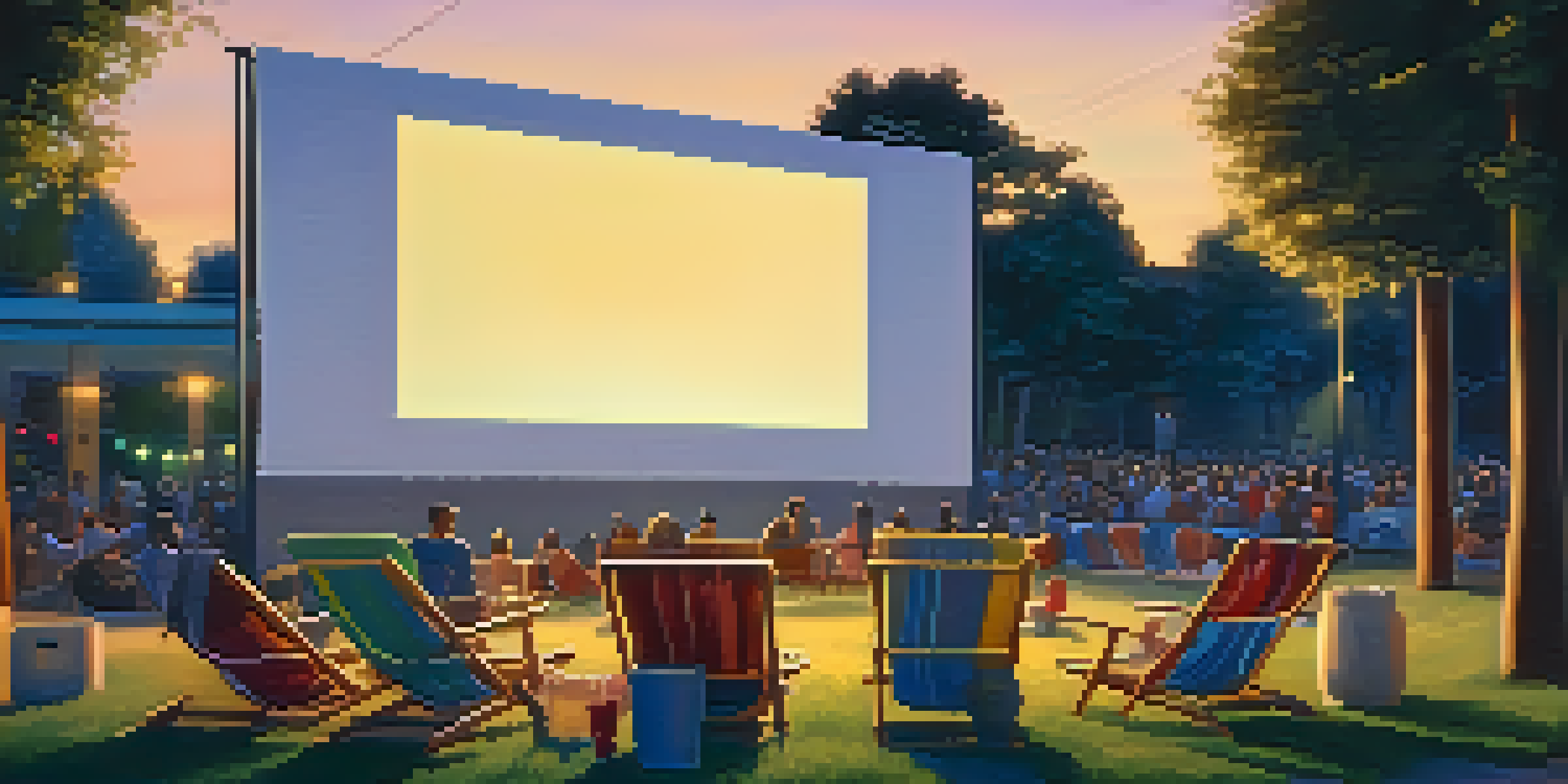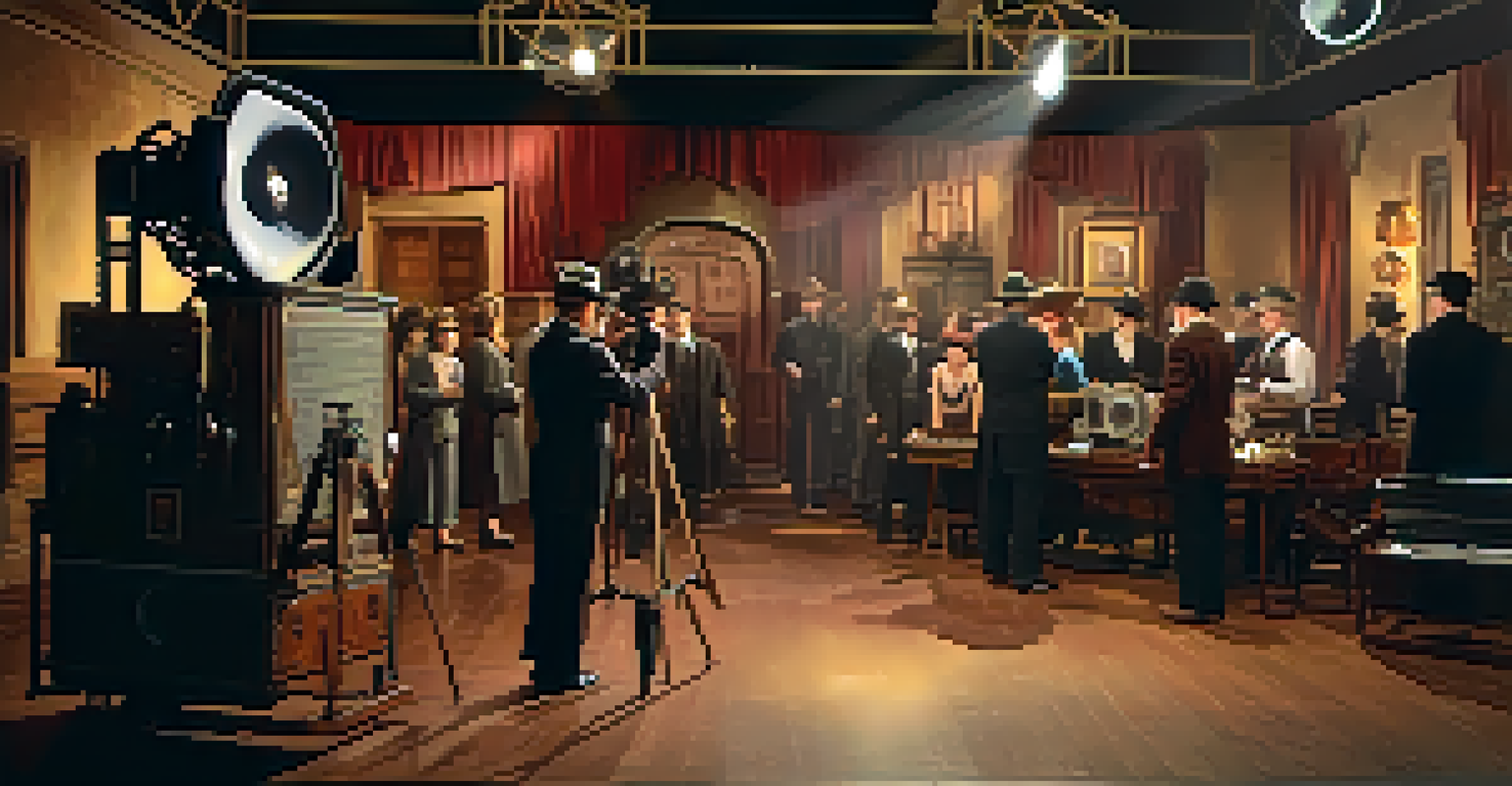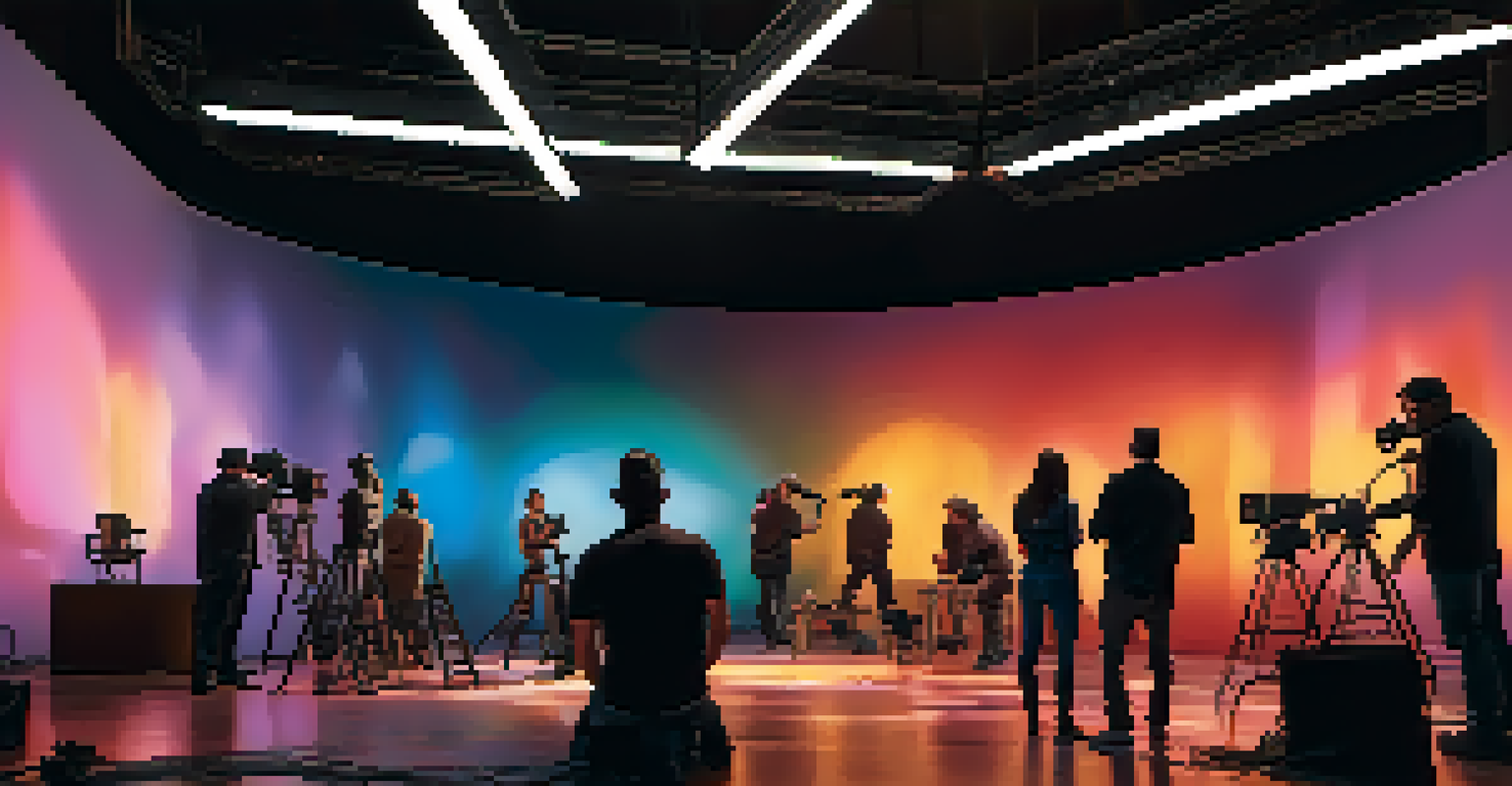The Evolution of Cinematic Lighting Techniques Through Decades

The Birth of Cinematic Lighting: 1890s to 1910s
In the early days of cinema, lighting was primarily natural and unrefined. Filmmakers relied heavily on sunlight to illuminate their scenes, which often resulted in a flat look. As studios began to emerge, they started experimenting with simple artificial lighting, using basic lamps to enhance visibility. This marked the beginning of a pivotal shift, where the mood and atmosphere of a film could be slightly manipulated through light, laying the groundwork for future innovations.
Lighting is a key element in the art of storytelling; it can create mood, depth, and emotion.
During this time, techniques such as chiaroscuro lighting, which emphasizes the contrast between light and dark, began to find their way into films. This method not only added depth to the visuals but also conveyed emotions and themes more effectively. Early filmmakers like Georges Méliès used these techniques to create magical, fantasy-driven narratives, showcasing the potential of lighting in storytelling.
By the end of the 1910s, as filmmakers became more aware of the impact of lighting on audience perception, they started to hone their skills further. This period laid the foundational principles of cinematic lighting, introducing the idea that lighting could do much more than just illuminate a scene—it could evoke feelings, define characters, and even foreshadow events.
The Rise of Studio Lighting: 1920s and 1930s
The 1920s brought a significant shift in cinematic lighting as studios adopted more advanced techniques and equipment. The introduction of electric lights allowed filmmakers to have greater control over their scenes, leading to more dramatic and dynamic visuals. This decade saw the birth of key lighting concepts, including three-point lighting, which involves the use of a key light, fill light, and backlight to create depth and dimension.

Notably, the emergence of sound films in the late 1920s also influenced lighting techniques. Filmmakers had to consider how lighting would affect sound recording, leading to more creative solutions. Directors like Fritz Lang began to use shadows and stark contrasts not only to enhance the visual storytelling but also to create a mood that set the tone for the film's narrative.
Cinematic Lighting Evolution
The journey of cinematic lighting has transitioned from natural sunlight to sophisticated digital techniques, enhancing storytelling.
This period also witnessed the rise of film noir in the 1940s, which heavily relied on low-key lighting to create a sense of mystery and suspense. The interplay of light and shadow became a hallmark of this genre, showcasing how studio lighting techniques evolved to cater to specific storytelling styles.
Naturalism Takes Center Stage: 1940s to 1960s
As cinema progressed into the mid-20th century, a new wave of filmmakers began to embrace naturalism in their lighting approaches. This era was characterized by a desire to create realistic, relatable environments that mirrored everyday life. Filmmakers like Roberto Rossellini and Vittorio De Sica utilized natural light to enhance the authenticity of their narratives, particularly in the Italian neorealism movement.
The camera is an instrument that teaches people how to see without a camera.
During this time, innovations in film stock and camera technology allowed for better low-light performance, enabling filmmakers to capture scenes in more diverse settings without relying on elaborate setups. This shift not only broadened the scope of storytelling but also encouraged filmmakers to think creatively about how they could use light to enhance the emotional weight of their stories.
Moreover, the 1960s marked the introduction of new lighting techniques, such as diffusion and gels, that allowed for a softer, more nuanced look. This evolution in lighting helped filmmakers explore a range of moods, from the dreamy sequences in French New Wave cinema to the stark realism of American dramas, illustrating the versatility of lighting in film.
Experimentation and Innovation: 1970s to 1980s
The 1970s and 1980s were marked by a spirit of experimentation in cinematic lighting, as filmmakers began to push boundaries and explore new artistic directions. The advent of new lighting technologies, such as HMI lights and fluorescent tubes, provided filmmakers with unprecedented flexibility and creative possibilities. Directors like Stanley Kubrick and Martin Scorsese utilized these innovations to create visually stunning and memorable scenes that captivated audiences.
In addition, the rise of music videos during the 1980s brought a fresh perspective to lighting. The vibrant, often surreal lighting techniques used in these short films influenced mainstream cinema, with directors adopting bold colors and dramatic lighting to evoke specific emotions or enhance visual storytelling. This led to the creation of iconic visuals that remain memorable to this day.
Studio Innovations Drive Change
The adoption of electric lights and advanced studio techniques in the 1920s and 1930s revolutionized visual depth in films.
This era also saw a growing emphasis on lighting as a storytelling device, with filmmakers increasingly using light to reflect character development and emotional arcs. For instance, the use of shadow in horror films became a powerful tool to build suspense and tension, showcasing how lighting could effectively influence audience perceptions and reactions.
Digital Revolution: 1990s to Early 2000s
The digital revolution in cinema during the 1990s brought about significant changes in lighting techniques, as filmmakers began embracing new technologies and digital tools. The introduction of digital cameras and editing software allowed for greater experimentation with lighting, making it easier to manipulate and enhance images in post-production. This shift opened up a world of possibilities for visual storytelling, enabling creators to achieve effects that were previously challenging to realize.
Moreover, the rise of CGI (computer-generated imagery) transformed the landscape of cinematic lighting. Filmmakers could now create fantastical worlds and characters, using digital lighting techniques to simulate realistic environments. This new approach not only expanded the creative toolkit but also challenged traditional notions of lighting, as the line between practical and digital effects began to blur.
As filmmakers explored the capabilities of digital technology, they also started to focus on the emotional resonance of their lighting choices. Directors like Christopher Nolan and Ang Lee utilized innovative lighting techniques to enhance their narratives, proving that even in a digital age, the fundamental principles of lighting remained crucial to effective storytelling.
Contemporary Trends: 2010s to Present
In recent years, cinematic lighting has evolved even further, with a strong emphasis on authenticity and emotional storytelling. Filmmakers are increasingly drawn to naturalistic lighting, often opting for practical sources such as lamps and streetlights to create immersive environments. This approach not only enhances the realism of the narrative but also establishes a deeper connection with the audience, inviting them to experience the story more intimately.
Additionally, advancements in LED technology have revolutionized the way filmmakers approach lighting. LED lights are energy-efficient, versatile, and can produce a wide range of color temperatures, giving filmmakers more tools to craft their desired look. This evolution has made it easier to adapt lighting setups on the fly, allowing for more dynamic storytelling and innovative visual styles.
Modern Focus on Authenticity
Contemporary filmmakers prioritize naturalistic lighting and innovative technologies, fostering deeper emotional connections with audiences.
Today, lighting is not just about illumination; it's a critical component of the storytelling process. Filmmakers like Greta Gerwig and Barry Jenkins are using light to explore themes of identity, culture, and emotion, showcasing how the evolution of lighting techniques continues to reflect the changing landscape of cinema. As technology advances, we can only imagine what the future holds for cinematic lighting.
Conclusion: The Ongoing Journey of Cinematic Lighting
The evolution of cinematic lighting techniques over the decades has been a fascinating journey, marked by innovation, creativity, and artistic expression. From the natural light of the early 1900s to the sophisticated digital techniques of today, filmmakers have continuously adapted their approaches to meet the demands of storytelling. Each decade has contributed to a richer understanding of how light can shape narratives and evoke emotions, creating a lasting impact on the audience.
As we look to the future, the possibilities for cinematic lighting are endless. With the continued advancements in technology and a growing focus on authentic storytelling, filmmakers will undoubtedly explore new horizons in their lighting techniques. Whether through virtual reality, augmented reality, or other emerging technologies, the integration of light in cinema will remain a vital aspect of the art form.

Ultimately, the evolution of cinematic lighting reflects the broader changes in society and culture, illustrating how filmmakers respond to the world around them. As we celebrate this journey, we can appreciate the artistry involved in crafting visually stunning films that resonate with audiences on multiple levels, reminding us of the power of light in storytelling.